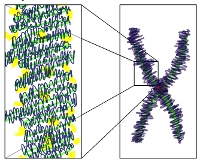Friday, March 19, 2010
"Epigenetics" drives phenotype?
"Researchers have identified a possible mechanism by which DNA regions that don't encode proteins can still determine phenotypic traits such as a person's height or susceptibility to a particular disease, researchers report online in Science today. The scientists found that certain chromatin modifications often considered to be epigenetic -- meaning, regulated by factors other than genetic sequence -- are in fact determined by a person's DNA. [...] If a non-coding SNP leads to a difference in chromatin structure and/or transcription factor binding, that effect can indeed be inherited, thereby providing a potential mechanism for transmission of phenotypes like disease susceptibility". Full article @ The Scientist.
Original Paper:
McDaniell et al. [2010]. "Heritable Individual-Specific and Allele-Specific Chromatin Signatures in Humans". Science. DOI: 10.1126/science.1184655

Original Paper:
McDaniell et al. [2010]. "Heritable Individual-Specific and Allele-Specific Chromatin Signatures in Humans". Science. DOI: 10.1126/science.1184655

Labels: epigenetics, inheritance, non-coding DNA
Friday, March 12, 2010
Cooperation in bacteria experiments
"...cooperation between species can be evolved in the laboratory if (1) there is preexisting reciprocation or feedback for cooperation, and (2) reciprocation is preferentially received by cooperative genotypes. [...] Growth in a spatially structured environment assured that the benefits of cooperation were preferentially received by cooperative genotypes. [...] cooperation disappeared if the waste consumption or spatial structure were removed." "This also happened when the bacteria were grown in flasks, suggesting that spatial structure of the bacterial colonies is needed for cooperation to evolve". Full article @ Evolution
Labels: bacteria, cooperation
Tuesday, March 02, 2010
Human Culture Plays a Role in Natural Selection
"Biologists are finding evidence that culture has been interacting with genes to shape human evolution. [...] Culture has become a force of natural selection, and if it should prove to be a major one, then human evolution may be accelerating as people adapt to pressures of their own creation". Full article @ NYTimes.com


